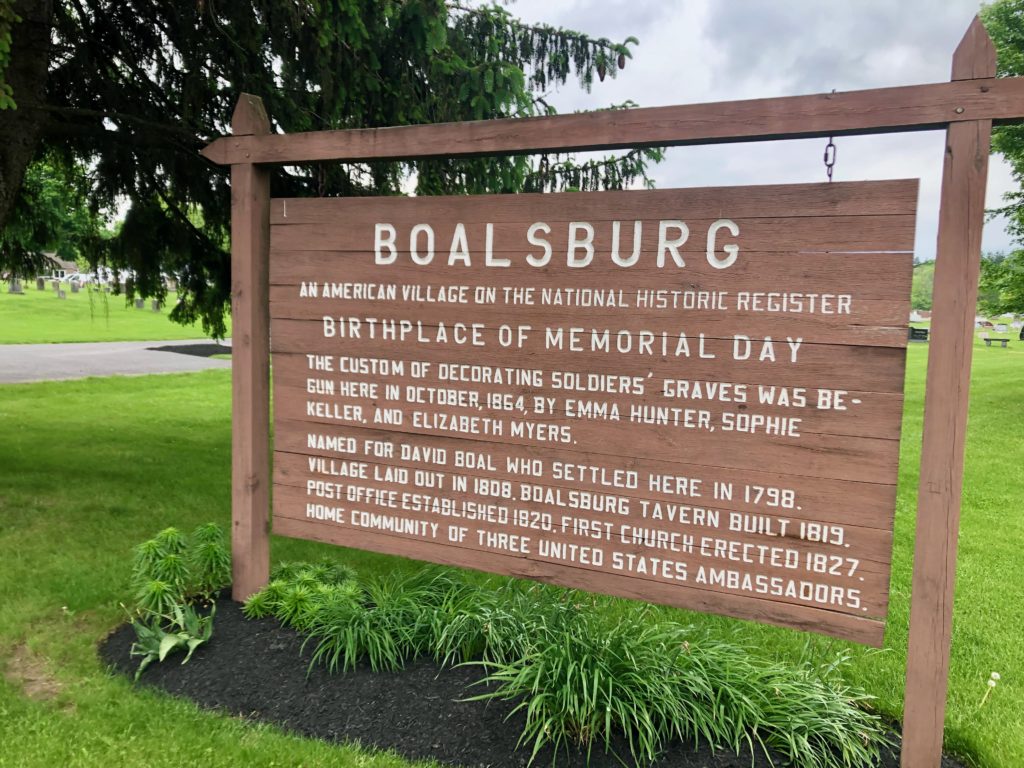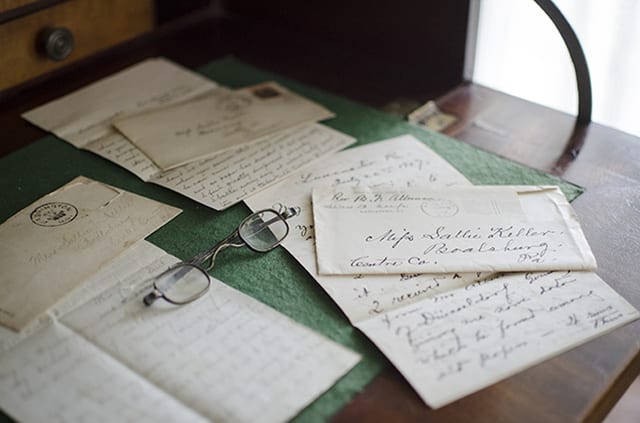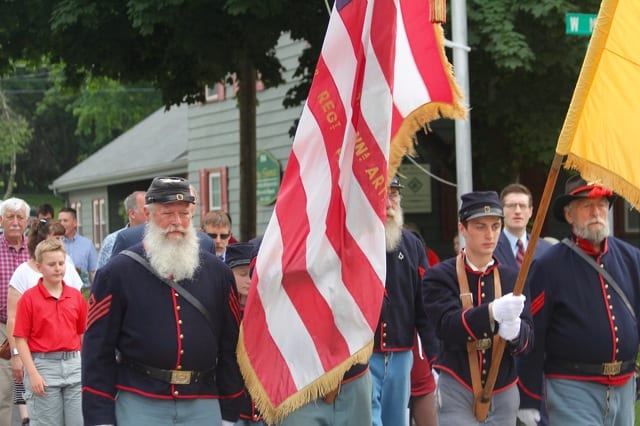Related: Boalsburg Memorial Day Weekend Events Return
Every year, Boalsburg celebrates its Memorial Day heritage that’s well-known to locals. As the story goes, during the Civil War, three women decorated soldiers’ graves at the cemetery in Boalsburg in the fall of 1864. The following year, they returned to the cemetery, along with people from the town, giving Boalsburg its claim as the birthplace for what later became known as Memorial Day.
Though the story was passed down for generations, there weren’t newspaper reports or photographs or other records to mark the event. The names of the three women — Emma Hunter, Sophie Keller and Elizabeth Myers — are known, but who they were and what brought them to the cemetery that day in October 1864 had been forgotten as the years turned into decades.
That’s all changed thanks to four local researchers.
After a fortuitous find brought them together, researchers Susan Evans, Bob Hazelton, Cathy Horner and Nancy Taylor spent years studying the three women, their families and Boalsburg during the Civil War. They uncovered new information, they rediscovered documents that hadn’t been associated with Boalsburg and Memorial Day for decades, and they put it all in context in a book — “A War, Three Women and a Tradition: A History of Boalsburg in the Civil War” — they hope will give future generations a richer understanding of the town’s significance.
“Hopefully, years from now people will read it and know the story,” Horner says. “Our goal was to keep that story alive.”
While the battleground of the Civil War in Pennsylvania was farther south from Boalsburg, the Centre County town bore witness to plenty of tragedy. Boalsburg lost three sons in May 1864 in the Battle of Spotsylvania Court House in northern Virginia, and two of the three women who went to the cemetery a few months later both lost loved ones. The researchers imagine that the war was very real on the minds of the townspeople.
“When the Civil War was raging, the people here in this area had to have been scared to death,” Horner says. “We figured out that after the second call [for soldiers] in Boalsburg, if you didn’t have someone in your family who went, you had a neighbor.”
Myers’s son, Amos, died in 1863 at the Battle of Gettysburg while he was serving with the 148th Pennsylvania Volunteer Infantry. Keller saw the war through her brother Daniel’s words, as the two had written letters back and forth. He was wounded at the Battle of Chancellorsville in spring 1863.
It was the death of Reuben Hunter, Emma’s father and the town surgeon, in September 1864 that was the catalyst for the event that helped create Memorial Day. Reuben died from yellow fever he contracted while caring for soldiers at a Union hospital in Annapolis, Maryland. A month later, on a Sunday, Emma was with her friend, Sophie Keller, at the Boalsburg Academy, putting together care packages to send to soldiers. Myers was there, too. Hunter told her friend that she planned to visit her father’s grave the following Sunday. Myers asked to go along, and they decided on a time to meet at the cemetery.

That piece of history was found in a trove of documents from Hunter’s husband, James Stuart, that have been preserved and housed in the special collections of Penn State’s Pattee Library, Hazelton says. The documents include wartime letters, photographs and a diary in which Stuart began recording notes on Decoration Day services in Boalsburg starting in 1869.
If it hadn’t been for an earlier lucky find, the researchers wouldn’t have even known that information was waiting to be found at Penn State. Months earlier, Horner and Evans had been organizing some archives at the Pennsylvania Room at the Centre County Library and Historical Museum in Bellefonte when they stumbled upon more than 60 neatly folded letters. The family name was one they recognized — Keller — and immediately associated with the Boalsburg Memorial Day story.
Many of the letters were from Keller’s brother. The soldier wrote about the war — he even explained how hot his Union uniform was, and he asked his family to sew him a new, lighter one.
“They read like a story,” Horner says. “It’s all about Boalsburg.”
Around the same time Horner and Evans discovered those letters, Hazelton rediscovered another set of Keller family letters. They’d been donated to the Centre County Historical Society by local businessman Gene Stocker, whose family once lived in the Keller home in Boalsburg and came into possession of the letters when the Kellers left them behind.
“I thought, gee, what a treasure this is,” Hazelton says.
He then enlisted the help of his friend Taylor, a genealogist, and not too long after that, they discovered that Horner and Evans came upon the other Keller letters. And that’s when the two groups started working together to advance the research behind the Boalsburg-Memorial Day story.

One of the additional finds they made was in a 1,000-page book published in 1904, The story of our regiment: a history of the 148th Pennsylvania Volunteers. It details the people in the infantry unit — its travels and battles. One of the chapters was written by Keller, who by then had been married for almost 30 years and was known as Sophie Keller Hall.
Keller’s piece, titled “The Sister’s Story,” described her brother Daniel going off to war in 1862 and the emotions she and her family had. At the end of her chapter was a note from the editor, who knew about her participating in decorating graves in Boalsburg some 40 years earlier. The editor, Joseph Muffly, a former adjutant of the Pennsylvania 148th, included a short testimonial from Keller, who he knew because her brother had gone on to work for James Beaver, who’d been governor of Pennsylvania and would be a future president of Penn State.
The note read, in Keller’s words: “On the 4th of July, 1864 (I think that was the first 4th of July following the death of Dr. Reuben Hunter, of Boalsburg), Emma Hunter, now Mrs. James T. Stuart, and I went to the Boalsburg Cemetery to decorate her father’s grave. While making a cross of flowers and wreath of same, the idea suggested itself to us that it would be appropriate, considering the day, to decorate all the graves of the soldiers buried there. Going home, we soon procured more flowers and laurel and made a wreath for every grave of a soldier, and as some of your boys of the 148th lie there, I think it can be said that the 148th was the first regiment to have its graves decorated.”
(The researchers see that Keller was mistaken about the month, as she wrote her recollection 40 years later.)

The researchers also rediscovered a series of local columns by Myrtle Magargel, a longtime journalist and historian with the State College Times and then the Centre Daily Times. For a series on the history of Boalsburg, Magargel interviewed one of Myers’s daughters, Adeline, who said she remembered gathering summer flowers and going to the cemetery with others. The researchers also found that Keller’s obituary in the local newspaper after she died in 1936 made reference to her as “one of the originators of the movement that led up to the establishment of Grand Army Memorial Day.”
While the researchers didn’t necessarily set out to prove that Boalsburg was the birthplace of Memorial Day, they didn’t expect to find the details they did. And while Waterloo, New York, has the official designation, the researchers are proud that Boalsburg has the stories and historical records to support the tradition that’s been handed down here.
Evans says she first saw the significance of her colleagues’ work in 2013, when a Girl Scout visiting the Boalsburg Heritage Museum asked whether Daniel Keller, pictured in a Civil War-era photograph they’d uncovered through the project, had lived.
“Bringing alive such buried history for future generations to examine,” Evans says, “was exactly the mission we hoped to accomplish.”
This article originally appeared in the April 2016 issue of Town&Gown.



